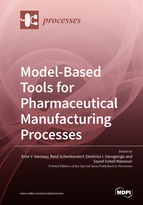Model-Based Tools for Pharmaceutical Manufacturing Processes
A special issue of Processes (ISSN 2227-9717). This special issue belongs to the section "Pharmaceutical Processes".
Deadline for manuscript submissions: closed (30 September 2019) | Viewed by 79063
Special Issue Editors
Interests: industrial fermentation technology; scale-up/scale-down; resource recovery; continuous production processes; mathematical modeling; process analytical technology (PAT)
Special Issues, Collections and Topics in MDPI journals
Interests: optimal experimental design; process systems engineering; sensitivity and uncertainty analysis
Special Issues, Collections and Topics in MDPI journals
Interests: bio/pharmaceutical manufacturing; food and beverage manufacturing; oil and gas systems engineering; process modeling, design and optimization
Interests: process system engineering; process control and optimization; downstream process development; chemical and biochemical process intensification
Special Issues, Collections and Topics in MDPI journals
Special Issue Information
Dear Colleagues,
Active pharmaceutical ingredients (APIs) are highly valuable, highly-sensitive products with strict quality control specifications and regulatory affairs in place. To ensure a profitable and growing pharmaceutical industry, model-based tools are fundamental to advancing the basic understanding, design and optimization of pharmaceutical manufacturing processes. Process analysis principles, for instance, provide a better understanding of underlying pharmaceutical manufacturing mechanisms. Model-based process design concepts facilitate identification of optimal production and purification pathways and configurations. Ideas of process monitoring ensure low life cycle cost and provide new insights into critical failure modes and drug quality control issues. These model-based concepts and combinations thereof are key to explore the whole potential of innovative highly-effective pharmaceutical manufacturing processes and are relevant ingredients of Quality by Design (QbD) policies.
This Special Issue on “Model-Based Tools for Pharmaceutical Manufacturing Processes” intends to curate novel advances in the development and application of model-based tools to address ever-present challenges of the traditional pharmaceutical manufacturing practice. Topics include, but are not limited to:
- Development of new modeling concepts for pharmaceutical manufacturing at different levels of aggregation (phenomena, unit operation, plant-wide);
- Design and optimization of pharmaceutical processes based on the derived models;
- Process intensification, robustification, and flexibilization of multipurpose pharmaceutical manufacturing platforms;
- Hybrid modeling combining classical first-principles models with (big) data-driven concepts
- Process control, monitoring and fault detection in pharmaceutical industry
Prof. Dr. Krist V. Gernaey
Dr. Rene Schenkendorf
Dr. Dimitrios I. Gerogiorgis
Dr. Seyed Soheil Mansouri
Guest Editors
Manuscript Submission Information
Manuscripts should be submitted online at www.mdpi.com by registering and logging in to this website. Once you are registered, click here to go to the submission form. Manuscripts can be submitted until the deadline. All submissions that pass pre-check are peer-reviewed. Accepted papers will be published continuously in the journal (as soon as accepted) and will be listed together on the special issue website. Research articles, review articles as well as short communications are invited. For planned papers, a title and short abstract (about 100 words) can be sent to the Editorial Office for announcement on this website.
Submitted manuscripts should not have been published previously, nor be under consideration for publication elsewhere (except conference proceedings papers). All manuscripts are thoroughly refereed through a single-blind peer-review process. A guide for authors and other relevant information for submission of manuscripts is available on the Instructions for Authors page. Processes is an international peer-reviewed open access monthly journal published by MDPI.
Please visit the Instructions for Authors page before submitting a manuscript. The Article Processing Charge (APC) for publication in this open access journal is 2400 CHF (Swiss Francs). Submitted papers should be well formatted and use good English. Authors may use MDPI's English editing service prior to publication or during author revisions.
Keywords
- upstream and downstream processes
- formulation
- bio-based and traditional organic synthesis based processes
- Quality by Design (QbD)
- continuous pharmaceutical manufacturing (CPM)
- big data
- hybrid models









